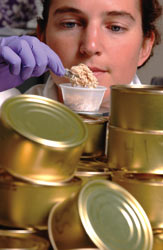Food scientists are taking a page out of the crime fighting handbook to figure out whether consumers and restaurants are actually getting the seafood they are paying for.
A study published in the Journal of Food Science and Technology demonstrates that a DNA testing can quickly and inexpensively tell you whether the fish you’re paying for is actually what you thought you were buying.

Food Scientist Rosalee Rasmussen Photo by Lynn Ketchum
“Fish and seafood substitution has become an important concern in domestic and international marketplaces, in part due to increased international trade, per capita seafood consumption, and production of processed foods,” says Rosalee Rasmussen of Oregon State University seafood laboratories in Astoria.
Investigators with the Food and Drug Administration say “economic deception or fraud in the sale of seafood occurs when a less expensive species is substituted for a more expensive species.” And, they added, “this misbranding is a federal crime.”
In the past, federal investigators have brought charges against importers and suppliers who knowingly misidentified species of fish to avoid paying steep import tariffs imposed to protect both U.S. fishers and endangered fish.
In at least two of the cases, the motivation to test the seafood came from obvious fraud on the shipping papers and, in the other, an informant.
Less expensive rockfish is often substituted for more expensive red snapper; yellowtail tuna instead of Mahi; sea bass for halibut; farm-raised Atlantic salmon for the finer tasting and richer wild Pacific, and even roe from paddlefish labeled as caviar from sturgeon.
In the article, Rasmussen and Prof. Michael Morrissey with the university’s Food Innovation Center in Portland, examined the impact of identifying bogus fish using the DNA techniques more common to CSI crime labs.
Both Rasmussen and federal food investigators say the amount of mislabeling actually is difficult to pin down because there is very little monitoring of the commercial fish supplies
“For example,” Rasmussen told me, “over 80 percent of the U.S. seafood supply is imported, but the FDA only examines about 2 percent of imported seafood.”
Last week, an FDA supervisor said she agreed with the Oregon scientists.
“We have so very few inspectors watching imported food that seafood is really low on the list,” she said. But “things may get better,” she said, because in March President Obama said he would “substantially increase the number of (FDA) food inspectors and modernize food safety labs.”
William Marler, one of the nation’s top food safety litigators, described the mislabeling as more of a fraud issue than a safety concern because fish and other seafood products, imported or not, make up a very small part of food that poisons consumers.
“From a consumer’s perspective of knowing if what they’re paying for is actually the seafood they thought they were buying, spot DNA testing makes much sense,” said the Seattle-based lawyer.
The food journal article is a compilation of substitution studies conducted by many scientists who have examined whitefish, such as hake, Pollock, and cod; tunas such as skipjack, albacore, yellowfin, and bluefin; and sturgeons, sharks and even commercial whale meat, Rasmussen explained.
I spoke to buyers and fishmongers at two national food chains who said they rarely get taken because they work closely with their suppliers and usually deal with the whole fish, which is easier to identify before it’s packaged as filets or steaks. Much more likely targets, they said, are restaurants or institutional buyers who purchase much of their imported fish cut and packaged into serving sizes.
Rasmussen cautioned that diners and consumers will have a much more difficult time telling if mislabeling has occurred if their dinner has been further processed, such as breaded and fried.
Here is a link to the journal article.
For a more extensive listing of seafood most often wrongly labeled, here is a link to an FDA website.
